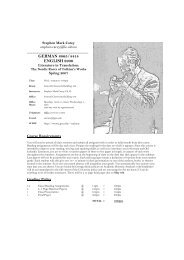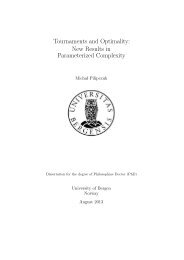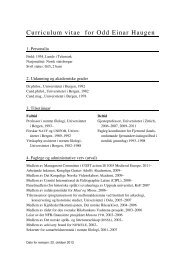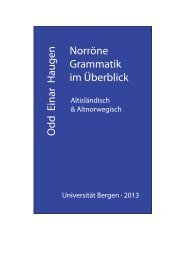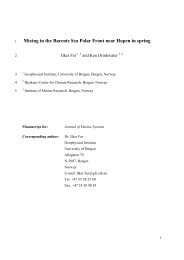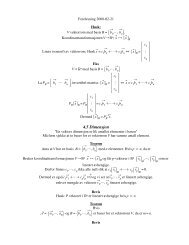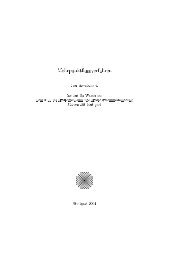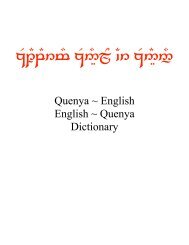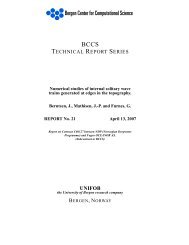Da hadde vært litt kult visst vi hadde snakka strilsk om hondra år”
Da hadde vært litt kult visst vi hadde snakka strilsk om hondra år”
Da hadde vært litt kult visst vi hadde snakka strilsk om hondra år”
You also want an ePaper? Increase the reach of your titles
YUMPU automatically turns print PDFs into web optimized ePapers that Google loves.
Abstract<br />
Title: “ It would have been cool if we spoke “<strong>strilsk</strong>” 25 in a houndred years fr<strong>om</strong> now.” A<br />
sociolinguistic longitudinal study of the spoken language in Øygarden.<br />
Student: Silje Villanger<br />
Super<strong>vi</strong>sor: Professor Helge Sandøy<br />
Department of Linguistic, Literary and Aesthetic Studies<br />
University of Bergen<br />
30.8.2010<br />
This sociolinguistic follow-up study is part of the project “Dialektendringsprosessar”, and the<br />
topic is variations and changes in the spoken language in Øygarden. The study is based on<br />
material gathered by Vidar Antonesen in 1983, and by me in the autumn of 2009. Antonesen’s<br />
material has been re<strong>vi</strong>ewed, and I have studied seven spoken variables by c<strong>om</strong>paring the<br />
material fr<strong>om</strong> the two studies. I have had 24 informants, of which 4 are panel informants who<br />
also took part in Antonesen’s study in 1983. The methods used in the two studies are<br />
different, and I have therefore re-processed Antonesen’s material.<br />
The study is both synchrone and diachrone as I have investigated both contemporary<br />
variations and changes that have taken place during the 26 years between the studies. I<br />
describe how the spoken language has changed and verify 5 hypotheses. This has been done<br />
by systemizing and c<strong>om</strong>paring all the material. Next I have tried to explain why the language<br />
has changed the way it has, and why the contemporary variations occur. Furthermore I have<br />
discussed the tendencies in the changes, and what changes that most likely will take place in<br />
the spoken language in Øygarden in the future. I do this by investigating social changes that<br />
have taken place in the period between 1983 and 2009. This is supplied by remarks given by<br />
the informants.<br />
I have found that the youngest informants in 2009, 13 to 15 year olds, have much younger<br />
variations of words in their spoken language than grown ups and the elderly. The two groups<br />
of grown ups have a very high percentage of traditional variations both in 1983 and in 2009.<br />
You can also find an emerging new pattern of changes in the youngest group. S<strong>om</strong>e of the<br />
25 ”Strilsk” is a very local word for the people who could row to Bergen in one day.<br />
121



